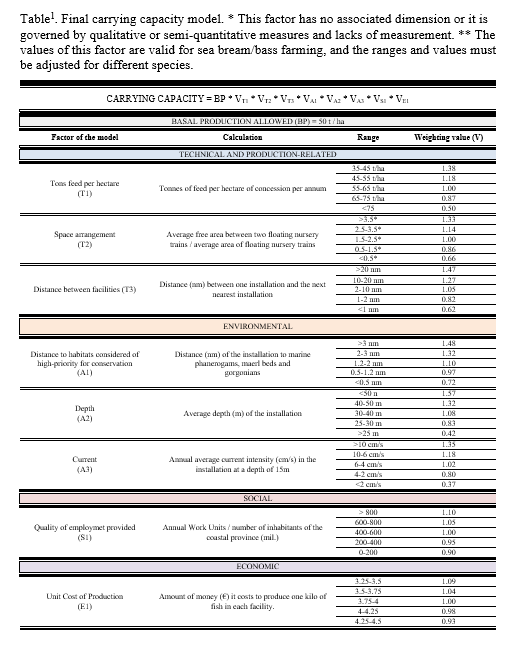A PROXY TO CARRYING CAPACITY FOR MEDITERRANEAN AQUACULTURE
Introduction
Over the last two decades, the European fish farming industry has been experiencing a progressive stagnation in production levels due to the rare of suitable areas for aquaculture because of the confluence of maritime space uses. Therefore, the planning and management of aquaculture areas aims to play a key role in their successful sustainable development. In this sense, its management should take into account not only the selection of the allocated zones for aquaculture (AZAs) if not the application of carrying capacity studies (Sanchez-Jerez et al., 2016; Macias et al., 2019; Weitzman et al., 2021). Therefore , in this study is intended t o develop a mathematical model for the calculation of carrying capacity, integrating productive, ecological and socio-economic factors, which can be used by public administrations to regulate aquaculture activity in the open sea on the Spanis Mediterranean cost.
M aterial and Methods
This study used a modified Delphi approach structured in three rounds. It started with the formation of a network of contacts through semi-structured interviews and ended with two rounds of questionnaires discussed in sectoral roundtables and workshops with experts to obtain a consensus on the value of the maximum allowable production (baseline production) and the different factors involved in increasing or reducing it.
Results and Discussion
During the first round, the experts identified a total of 39 indicators classified according to their type of carrying capacity (technical-productive, environmental, social and economic) and their degree of importance. After the first round, 18 of the 39 indicators were excluded from the study and in addition, 3 new ones were also identified, bringing the total of 11 factors as possible estimators of carrying capacity. After a consensus analysis by the Delphi expert panel, Round 2 ended with a model proposal based on a baseline production and 8 factors carrying capacity estimators, together with their respective ranges and weighting values . Due to its high restrictive power and observing the possible inconsistencies of the model, Round 3 ended with a final readjustment of the model (Table 1 ) in order to provide a new tool for the Spanish fish farming, available for producers and administrators for the innovative management of the Spanish aquaculture since its formulation is based not only on ecological, but also on social and economic aspects selected and defined by marine aquaculture stakeholders.
This project is carried out with the collaboration of Fundación Biodiversidad , of the Ministerio para la Transición Ecológica y el Reto Demográfico , through Pleamar Program, cofinanced by FEMP. We thank the collaboration of the three companies that gave us access to their facilities.
References
Macias, J.C., Avila Zaragozá , P., Karakassis, I., Sanchez-Jerez, P., Massa, F., Fezzardi , D., Yücel Gier , G., Franičević , V., Borg, J.A., Chapela Pérez, R.M., Tomassetti , P., Angel, D.L., Marino, G., Nhhala , H., Hamza, H., Carmignac , C. & Fourdain, L. (2019) . Allocated zones for aquaculture: a guide for the establishment of coastal zones dedicated to aquaculture in the Mediterranean and the Black Sea. General Fisheries Commission for the Mediterranean. Studies and Reviews. No 97. Rome, FAO. 90 pp
Sanchez-Jerez, P., Karakassis, I., Massa, F., Fezzardi, D., Aguilar-Manjarrez , J., Soto, D., Chapela , R., Avila, P., Macias, J. C., Tomassetti , P., Marino, G., Borg, J. A., Franičević , V., Yucel-Gier , G., Fleming, I. A., Biao, X., Nhhala , H., Hamza, H., Forcada , A., & Dempster, T. (2016). Aquaculture’s struggle for space: The need for coastal spatial planning and the potential benefits of Allocated Zones for Aquaculture (AZAs) to avoid conflict and promote sustainability. Aquaculture Environment Interactions, 8, 41–54.
Weitzman, J., Filgueira, R., & Grant, J. (2021). Development of best practices for more holistic assessments of carrying capacity of aquaculture. Journal of Environmental Management, 287, 112278.
